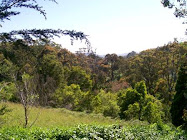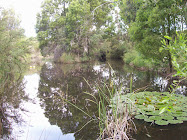Conversely there are others who would not have a sniff of a native plant in their garden.
As in most things perhaps the middle way is to be recommended.
At our place, we have tried to keep the area that is more removed from the house as pure as possibly, almost indigenous to this area. The majority of trees are the Blackwood (Acacia melanoxylon) Mountain Ash (Eucalyptus Regnans) and Yellow Box Eucalyptus melliordora. There are rough tree ferns Cyathea australis, soft tree ferns Dicksonias and the local rasp fern down by the creek. Lots of the good old Crimson bottlebrush Callistemon citrinus and beds of Goodonia.
The area surrounding the house is a different story. Here, there are natives mixed with exotics or just exotics on their own like the rose bed .... or the veggie patch for that matter. Aussie Bush tucker may be OK but the old veggie patch is full of exotics like broccoli, turnips, parsnips, rocket, lettuces, rhubarb and of course tomatoes.
The photos show a Cherry plum blooming away in amongst the natives,seeded by the birds and there is a stand of the African daisy blooming on a very steep part of the hillside. Both look suitably comfortable in their surroundings.


.jpg)

.jpg)



No comments:
Post a Comment